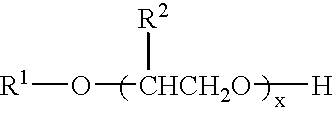Fuel additive, additive-containing fuel compositions and method of manufacture
a technology of additives and fuel additives, which is applied in the direction of fuel additives, liquid carbonaceous fuels, fuel additives, etc., can solve the problems of not being effective in reducing no.sub.x emissions, known emission control systems and strategies have associated disadvantages, and achieve high solubilization of nitrogen-containing compounds, reduce no.sub.x emissions, and reduce the effect of no.sub.x
- Summary
- Abstract
- Description
- Claims
- Application Information
AI Technical Summary
Benefits of technology
Problems solved by technology
Method used
Image
Examples
example 1
[0071] An exemplary fuel additive according to the invention was prepared. In a 250-ml beaker, the constituents listed in the following table were mixed with a spatula to prepare a 100 gram (50 / 25 / 25 wt. %) carrier blend composition:
1TABLE 1 Carrier blend Constituents of Example 1 Constituent Product I.D. Amount Alcohol ethoxylate Tomadol 91-2.5 50 grams Polyethylene glycol diester Lumulse 62-O 25 grams of oleic acid Oleic acid diethanolamide Comperlan OD 25 grams
[0072] In a separate 100 ml beaker, 21.5 grams of urea were dissolved in 32.3 grams of water (40 wt.% urea solution). The urea solution was poured into the carrier blend and mixed with a spatula. The resulting fuel additive was observed to be viscous and in a near gel state. The 153.8 gram fuel additive contained approximately 14% urea by weight.
[0073] The additive was added to #2 diesel fuel to obtain a fuel formulation with an additive concentration of 0.225% by weight and a urea concentration of 1 gram / gallon. 7.14 grams...
example 2
[0074] An exemplary fuel additive concentrate according to the invention was prepared. 35 grams of fuel additive of Example 1 were admixed with, 65 grams (77.7 ml) of #2 diesel fuel with a spatula in a 250 ml beaker. The gelatinous additive composition was stirred into the diesel fuel and allowed to stand for one hour at which time all the gel particles had dissolved. The resulting concentrate was a clear fluid with a specific gravity of 0.8914. The concentrate contained approximately 4.9% urea and 65% diesel fuel by weight.
[0075] The concentrate of this Example was then added to a #2 diesel host fuel to obtain a fuel formulation with an additive concentration of 0.64% by weight and a urea concentration of 1 gram / gallon such as could be used in an internal combustion engine. 20.4 grams of concentrate were added to 1 gallon (3160 grams) of the diesel fuel to achieve the desired 1 gram / gallon urea concentration. The concentrate was a liquid and was not viscous. The concentrate dissolv...
example 3
[0082] A further exemplary fuel additive concentrate according to the invention was prepared. In a 400-ml beaker, the constituents listed in following table were admixed with a spatula to prepare a 100 gram (34 / 33 / 33 wt. %) carrier blend composition:
2TABLE 2 Carrier Blend Constituents of Example 3 Constituent Product I.D. Amount Alcohol ethoxylate Tomadol 91-2.5 34 grams Polyethylene glycol ditallate Mapeg 600-OT 33 grams Oleic acid diethanolamide Mackamide MO 33 grams
[0083] The 100 grams of carrier blend were admixed with 71.5 grams of #2 diesel fuel. The carrier blend dissolved readily in the diesel fuel.
[0084] Separately in a 100 ml beaker, 40 grams of water were admixed with 26.7 grams of urea until the urea had dissolved. The aqueous 40 wt.% urea solution was added to the carrier blend / diesel composition. The solution became clear and homogeneous after a few minutes of mixing. The resulting fuel additive concentrate had a viscosity of 435 centipoise at 22.degree. C. as determin...
PUM
| Property | Measurement | Unit |
|---|---|---|
| weight percent | aaaaa | aaaaa |
| wt. % | aaaaa | aaaaa |
| wt. % | aaaaa | aaaaa |
Abstract
Description
Claims
Application Information
 Login to View More
Login to View More - R&D
- Intellectual Property
- Life Sciences
- Materials
- Tech Scout
- Unparalleled Data Quality
- Higher Quality Content
- 60% Fewer Hallucinations
Browse by: Latest US Patents, China's latest patents, Technical Efficacy Thesaurus, Application Domain, Technology Topic, Popular Technical Reports.
© 2025 PatSnap. All rights reserved.Legal|Privacy policy|Modern Slavery Act Transparency Statement|Sitemap|About US| Contact US: help@patsnap.com



